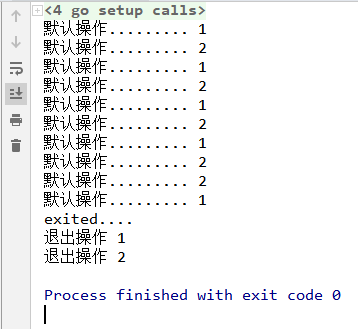package main
import (
"context"
"fmt"
"time"
)
var (
cxt context.Context
cxt1 context.Context
cancelFunction context.CancelFunc
)
func gooo(ctx context.Context,num int){
for{
select{
case <-ctx.Done() :
fmt.Println("退出操作",num)
return
default:
fmt.Println("默认操作.........",num)
time.Sleep(time.Second*2)
}
}
}
func main() {
cxt = context.Background()
cxt, cancelFunction = context.WithCancel(cxt)
cxt1,cancelFunct := context.WithCancel(cxt)
go gooo(cxt, 1)
go gooo(cxt1,2)
// cancelFunction = cancelFunction
time.Sleep(time.Second*10)
cancelFunct()
time.Sleep(time.Second * 10)
cancelFunction()
fmt.Println("exited....")
}
package main
import (
"context"
"fmt"
"time"
)
var (
cxt context.Context
cxt1 context.Context
cancelFunction context.CancelFunc
)
func gooo(ctx context.Context,num int){
for{
select{
case <-ctx.Done() :
fmt.Println("退出操作",num)
return
default:
fmt.Println("默认操作.........",num)
time.Sleep(time.Second*2)
}
}
}
func main() {
cxt = context.Background()
cxt, cancelFunction = context.WithCancel(cxt)
cxt1,_ := context.WithCancel(cxt)
go gooo(cxt, 1)
go gooo(cxt1,2)
// cancelFunction = cancelFunction
time.Sleep(time.Second * 10)
cancelFunction()
fmt.Println("exited....")
time.Sleep(time.Second*300)
}

